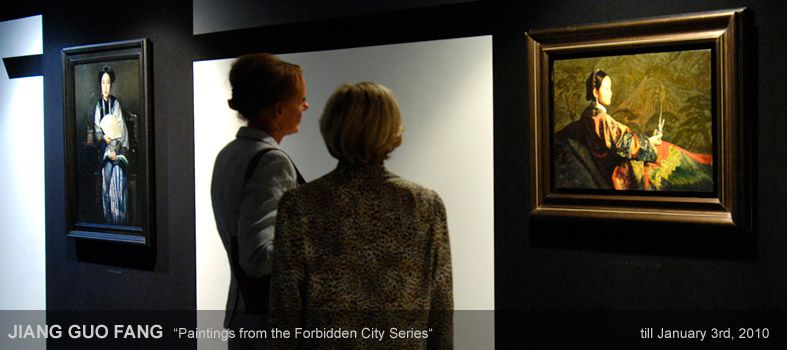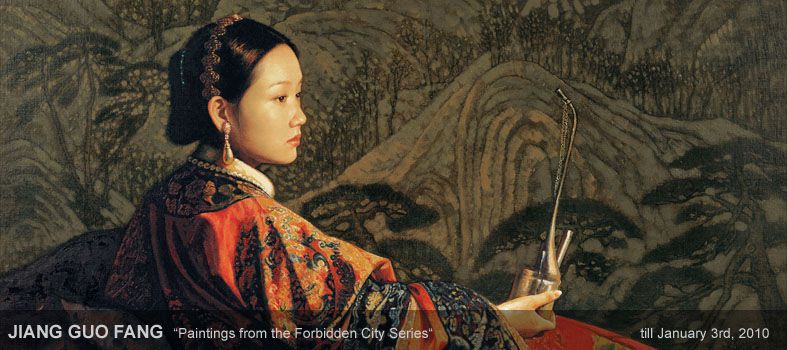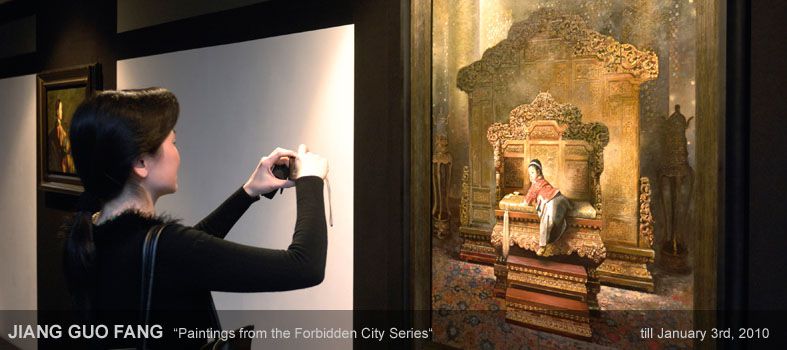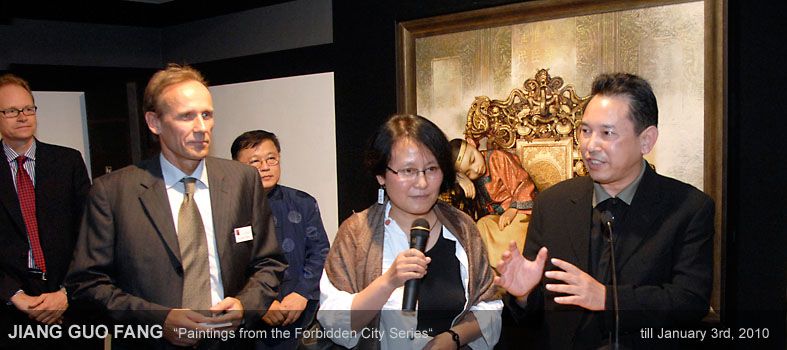
Jiang Guofang and curator Thomas Tyllack in front of the painting
'Dream', 146 x 112 cm, 2006
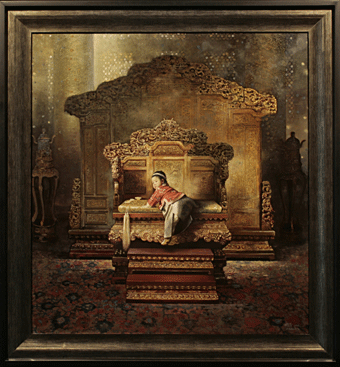
Son of Haeven, 101 x 109 cm
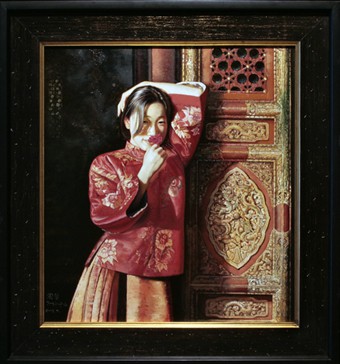
Spring Breeze comes to the Forbidden City, 67 x 60 cm
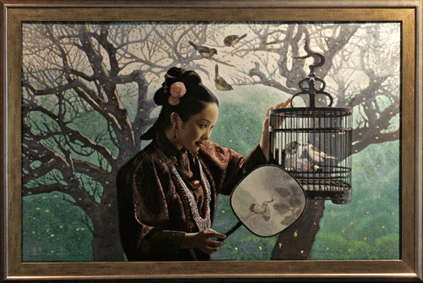
The Song of Morning, 150 x 95 cm, 2006
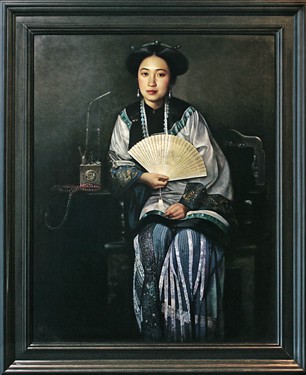
A Palace Maid, 100 x 81 cm, 2006
JIANG GUOFANG exhibition Berlin
Oil Paintings from the FORBIDDEN CITY Series
Opening on Sept. 23rd, 2009"Given the gigantic cultural system embodied by the Forbidden City, one might also say I studied it. As I painted and considered it, I was able to continually deepen my understanding of it. Creating the series of oil paintings of the Forbidden City was systematic work, requiring artistic breakthroughs. Yet, more importantly, it called for a proper understanding of the Qing dynasty history. Based on this, art and history can be ingenuously combined to create pictures with distinct features of the time that are also accompanied by a profound connotation. This task is difficult to accomplish. Take historical materials, for example. A tremendous amount of historical data, including several million pieces of artefacts, is preserved in the Forbidden City. The First Historical Archives of China also contain more than 10 million documents. One cannot finish reading them, even if one would take 60 years to do so." Jiang Guo Fang
Son of Heaven
Before Emperor Yongzheng, the succession to the throne followed basically the following rule: The eldest son of the empress was the first successor. If the empress had no son, the eldest son born of an imperial concubine became the successor. If the imperial concubines had no son, a son was to be adopted from among the imperial clan, or the throne was to be succeeded by the emperor's younger brother. This was the so-called system of succession by the eldest direct descendant.
This system of succession by the eldest direct descendant was not adopted in the early Qing period until Emperor Kangxi, who began to follow the tradition of the regimes in the Central Plains. The disadvantage of this system was obvious. If the eldest direct descendant did not have the capacity to rule a country, or if the emperor was not satisfied with him and wanted to replace him with someone else, there would be open or veiled struggle among the princes. Emperor Kangxi had deposed the crown prince and replaced him with another heir apparent.
Emperor Yongzheng ascended to the throne when he was already 45 years old. He had himself witnessed the troubles experienced by Emperor Kangxi when he decided to depose the crown prince. Shortly after he mounted the throne, Yongzheng decided on a system of secret designation of the crown prince. The name of the designated heir apparent was written on a sheet of paper, placed in a box and hidden behind the horizontal board in the Hall of Heavenly Purity inscribed with the four characters for "Upright and Honorable" in the handwriting of Emperor Shunzhi (reigning 1644-1661). It was to be opened and the name of the heir apparent announced only when the reigning emperor was dying. This was how Emperors Qianlong, Jiaqing and Daoguang succeeded to the throne. This method of naming the successor helped consolidate the imperial power and stabilize the political situation.
The painting Spring Breeze Comes to the Forbidden City is based on a historical event. In the spring of 1903, two princesses came to the Forbidden City from abroad. One of them was Deling, and the other, Rongling. They had lived in foreign countries with their father Yugeng, who was a diplomat of the third rank and had served as the minister to Japan, France and other countries at the end of Qing dynasty. Soon after returning to Beijing, they were summoned to the palace to serve as Empress Dowager Cixi“s women court officials, or secretaries in the language of today. As Deling had lived in foreign countries for many years, she knew more about Western civilisation. The Empress Dowager became interested in Western lifestyle, culture and art, religious belief and the Chinese in the eyes of Westerners. Deling was deeply favoured by the Empress Dowager, who always consulted her on important foreign affairs. As the declining dynasty struggled for the last time in the mists of history, Deling made use of her special capacity and exerted ceaseless influence on Cixi like a rainbow below a setting sun and brining a slim hope for survival in the tightly closed Forbidden City.
From: Discovering the Forbidden City - Jiang Guofang and His Oil Paintings of the Imperial Palace. Beijing, 2009
"When I was teaching at the Central Drama Institute, most of the graduation plays staged by students of the Directing and Performing Departments were classical ones, such as Macbeth, King Lear and Romeo and Juliet. As these plays were all staged against the background of court life, I began to concern myself with the life of these women. Although all their life was fictitious and far from reality, they provided me with room for imagination surpassing time and space. The other reason for my painting of palace women was because I was doing the Forbidden City Series, a project with court life as the main theme. Other than the emperor, women were the main group of people active in the rear quarters of the palace. They were a typical group of Chinese women embodying the social style and features of the time.
I have to admit that when I painted the series of pictures of palace women, I was influenced by Ingres and the ancient Chinese pictures of women painted with fine brushwork. The two enabled me to find an art form that is acceptable to the aesthetic taste of the contemporary people. People of today generally do not want to face the harsh and corrupt life in the palace. Through works of art, they are more willing to see the shining and joyous side of life, the graceful figures of the palace women of the past, their peaceful minds and youthful spirit in their innermost hearts. These considerations set a difficult problem for the artist. When an artist paints pictures of ancient and classical subjects, does he have to paint them with a dignified and deep ideological content and a tragic touch?" Jiang Guo Fang
back >>

